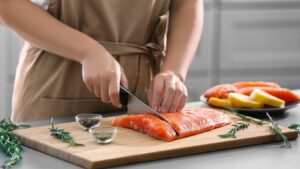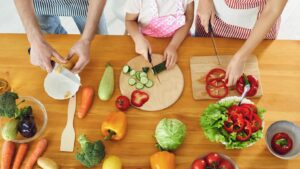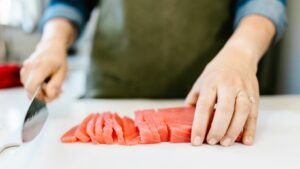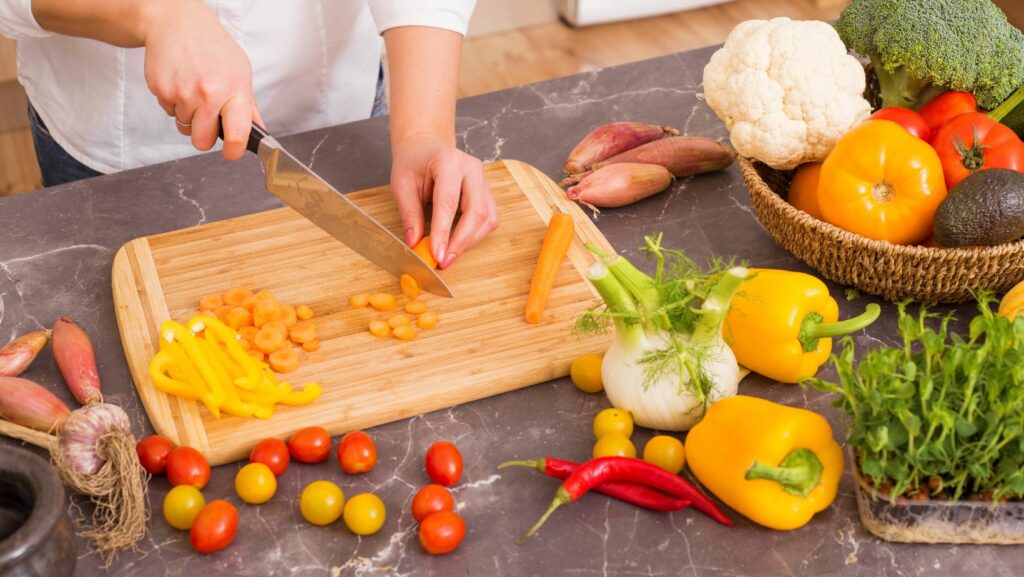In the culinary world, the term ‘cut’ takes on a whole new meaning. It’s more than just a simple slice or chop. It’s an art, a science, and a language all rolled into one. Understanding the different types of cuts and their uses can elevate any home cook’s skills to a professional level.
Cut In Cooking Definition

Cutting, one of the fundamental techniques in cooking, plays a vital role beyond aesthetics or fitting pieces into a pot. It affects cooking time and the way flavors meld. For instance, a diced onion cooks faster and more evenly than one sliced into large pieces, while a thick cube of beef takes longer to cook than thin strips.
Cuts come in three major categories based on their size – small, medium, and large. Small cuts like the brunoise measure 1/8 inch and are perfect for delicate sauces or garnishes. Medium cuts such as the julienne or batonnet measure 1/4 to 1/2 inch, ideal for stir fry or salads. Large cuts, like chunks and chops, are typically an inch or larger, suited to roasting or stewing.
Size isn’t the sole consideration, shape impacts cooking too. For instance, a chiffonade – thin ribbons of leafy vegetables – introduces a different texture and visual appeal compared to a rough chop. Knowing your cuts, therefore, provides control over the look, taste, and cook of your dish.
Techniques and Tips for Cutting In

Delving deeper into the world of culinary cuts involves mastering specific techniques. First, the cook selects the right kitchen knife. Typically, a sharp chef’s knife gives the best control over a variety of cutting tasks. Secondly, maintaining a firm grip and appropriate knife position ensures accuracy, creating uniform cuts that cook evenly.
Practice forms the basis of skill improvement. Repeating cuts such as mincing, dicing, and julienning enhance the cook’s dexterity and familiarity. Additional techniques like the claw grip, which protects the fingers while maintaining a steady food guide, add safety to skill mastery.
Lastly, understanding the impact of cut sizes on cooking times forms a crucial component. For instance, smaller cuts cook faster than larger ones. Tiny cubes, such as the brunoise cut, often used in sauces and garnishes, cook almost instantly. Conversely, larger cut meats require more extended cooking times.
Applications of Cutting In in Different Recipes

Expanding on the importance of precise cuts in cooking, different recipes evidently require specific cutting techniques. For instance, making a julienne of vegetables, popular in French cuisine, involves the selection of an apt knife, utilizing a firm grip, and practising the right technique. Undertaking this cut transforms the dish’s aesthetics, texture, and even its cooking time. In predominantly soup recipes like the classic French Potage Parmentier or a hearty Italian Minestrone, a uniform dice of vegetables, known as brunoise cut, is key.
Lastly, mincing – essentially fine chopping – is critical in recipes calling for finely cut ingredients like garlic or herbs. This technique aids in releasing the maximum flavor, ensuring dishes like Aglio e Olio reach their peak aroma and taste. To summarize, various cutting techniques have unique applications spread across diverse recipes, and mastering them ensures culinary success.
Comparative Analysis
Understanding the art of culinary cutting is not just about wielding a knife. It’s about mastering techniques that can elevate a dish’s aesthetics, textures, and flavors. From julienne vegetables to brunoise in soups, chiffonade in salads, and batonnet in stir-fries, precise cuts make a world of difference. Even the smallest details like mincing garlic or herbs can have a significant impact on the final outcome. Additionally, safety can’t be overlooked. Techniques like the claw grip ensure efficiency without compromising personal safety. So, whether you’re a home cook or a professional chef, knowing your cuts is an essential step towards culinary success. It’s not just about food preparation; it’s about crafting an experience.

